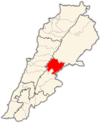Karak Nuh
Karak
كرك كرك نوح | |
|---|---|
| Coordinates: 33°51′0″N 35°55′35″E / 33.85000°N 35.92639°E | |
| Country | Lebanon |
| Governorate | Beqaa |
| District | Zahlé |
| Time zone | GMT +2 |
| • Summer (DST) | +3 |
| Area code | (+961) 8 |
Karak (also Kerak, Karak Nuh or Karak Noah) (
History
The town was an important religious site during the Middle Ages, drawing devotion from the local rural village communities.[2] The town was known as al-Karak during the time of the Ayyubid dynasty and changed to Karak Nuh under the Mamluks.[4]
In
A
A major earthquake damaged the town's distinguishing minaret in 1705, which required repair by the 'Alwan family.[2]
In 1838,
Tomb of Noah
According to tradition mentioned by
Archaeology
A Roman inscription in Latin dating to the year 84 CE was found in the basement of a house to the south west of the tomb that called for the long life of the "man with many names".[10]
Locale
Near to the town is the Ayn al-Garr spring and Massyas lake and marshes that are considered to be the source of the Litani river.[14]
Notable people
- Ahmad bin Tariq bin Sinan al-Karaki (1132–1195), Shia muḥaddith and grandson of Karak's former qadi
- Muhaqqiq al-Karaki (1465–1534), Shia scholar and Safavid Empire during the early reign of Tahmasp I
- Muhammad al-Harfushi (d. 1649), cloth-maker, Arabic grammarian and poet from Karak Nuh who was persecuted for his Shia faith in Damascus and then moved to Iran where he received an official state post
- Husayn al-Mujtahid al-Karaki, Shia scholar and maternal descendant of Muhaqqiq al-Karaki, served as Shaykh al-Islām of Qazvin and Ardabil
See also
References
- ^ "Zahleh - Maallaqa - Taanayel". Local Liban. 22 February 2006. Retrieved 5 October 2020.
- ^ a b c Winter, 2010, p. 43 ff
- ^ "Municipal and ikhtiariah elections in the Beqa'a 147 municipalities and 414 mokhtars" (PDF). The Monthly Magazine. February 2010. Archived from the original (PDF) on 4 March 2016.
- ^ Sourdel, D., " Karak Nūḥ." Encyclopaedia of Islam, Second Edition. Brill Online , 2012. Reference. 3 October 2012
- ^ Yunini, Qutb ad-Din. Dhayl mir'at al zaman.
- ^ Khalife, Issam (2004). The Districts of Lebanon in The 16th Century (in Arabic). p. 125.
- ISBN 9789781025488.)
{{cite book}}: CS1 maint: location missing publisher (link - ^ Robinson and Smith, 1841, vol 3, 2nd appendix, p. 143
- ^ Le Strange, 1890, p. 480
- ^ a b c Royal Anthropological Institute of Great Britain and Ireland (1871). Journal. p. 323.
- ^ Ḥaddād, 1956, p. x
- ^ Sourdel-Thomine, Janine, 'Inscriptions arabes de Karak Nuh', Bulletin d'Etudes Orientates, 13: 71-84, (1949-51)
- ^ Burton, p. 40 ff
- ^ Lipiński, 2000, p. 307 ff
Bibliography
- ISBN 978-1-4400-4321-5.
- Ḥaddād, Jūrj Marʻī (1956). Baalbak, North & South Lebanon: Description, history and touristic guide. Printed by el-Hashimieh Press.
- Le Strange, G. (1890). Palestine Under the Moslems: A Description of Syria and the Holy Land from A.D. 650 to 1500. Committee of the Palestine Exploration Fund.
- ISBN 978-90-429-0859-8.
- Robinson, E.; Smith, E. (1841). Biblical Researches in Palestine, Mount Sinai and Arabia Petraea: A Journal of Travels in the year 1838. Vol. 3. Boston: Crocker & Brewster.
- ISBN 978-0-521-76584-8.


